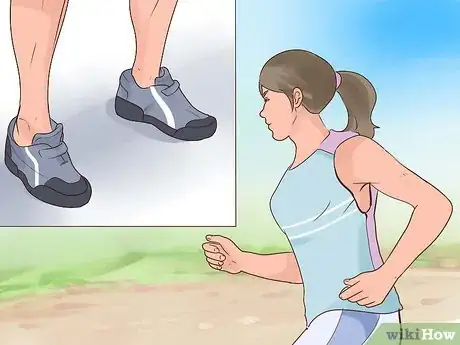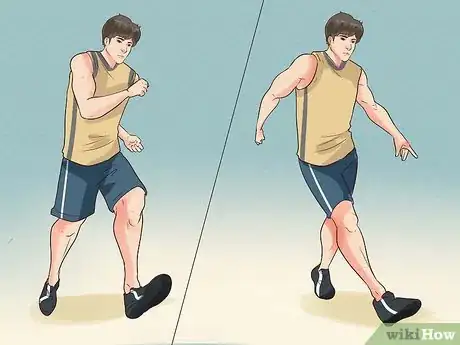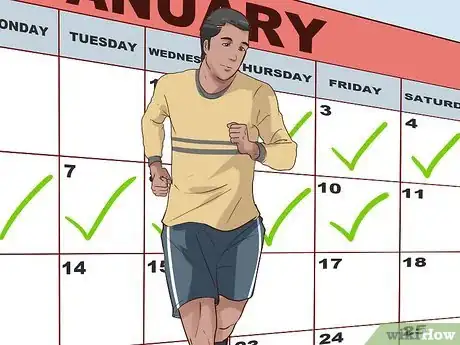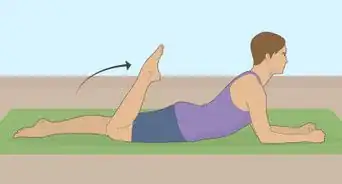This article was co-authored by Francisco Gomez. Francisco Gomez is the Head Coach at the FIT Potato Gym, a training gym established in 2001 in the San Francisco Bay Area. Francisco is a former competitive runner who helps endurance athletes train for major marathons like the Boston Marathon. Francisco specializes in Injury Rehab, Flexibility, Marathon Training, and Senior Fitness. He has a B.S. in Nutrition and Exercise Physiology & Running.
There are 10 references cited in this article, which can be found at the bottom of the page.
This article has been viewed 255,788 times.
Wondering how to run a long distance? Perhaps you need some tips? This guide should help you become a better long distance runner.
Steps
-
1Eat and drink well before and after each run.[1] Have a power bar or banana at least half an hour before your run so that you will be adequately fueled throughout the run.[2] Afterwards, eat a good meal to help you recover from the workout.[3] Make sure you hydrate well before your run -- guzzling large amounts of water right before you start won't help hydrate you throughout a long run; in fact doing that might give you painful running cramps.[4]
-
2Plan your run. Decide what distance you want to run and where you want to go. Consider factors like hills and running surface when planning your route. Hills tend to be harder to run.[5]Advertisement
-
3Dress appropriately. Wear light weight running shoes that are in good condition and fit your feet well. Wear cool, comfortable clothes that will wick sweat while you run.
-
4Take a warm-up lap around the block, school, track, or any other place that will take a few minutes to run around.[6]
-
5Do various stretches to help loosen your muscles.[7] Focus on the legs, but also stretch your arms, back, and core.
-
6Complete your run. Try to run the whole way at a consistent pace. If you need to, walk for a few minutes before running again, but don't stop. Pay attention to your form: make sure not to be tense in the upper body, as this will tire you out much faster. Also make sure to run from the middle of the foot to the toe (land on the ball of your foot and lift off from the toes).
-
7Breathe well. Breathing is important in running long distances and learning how to breathe while running can help tremendously.[8]
-
8After running, rest and drink water. Stretch well to minimize soreness after the run.[9]
-
9Run every day. This will help condition your body and get yourself used to running. This will be hard at first, but you will get stronger and start to feel more comfortable running.
-
10Gradually build up your distances each time you run.[10] If you have never run before start at 1 kilometer (0.62 mi). When you can comfortably run that, try to go a little farther. Gradually increase to 5 kilometers (3.1 mi), then 10 kilometers (6.2 mi). Continue to push yourself until you achieve your distance goal.[11]
-
11Enter some races! If you are in Junior High or High School join the track and cross country team, or join a local running club and enter races in your town or city. Try to get a personal best each time you do a race.
-
12Keep at it! Distance running is very difficult and not many people keep it up. But you can! People will really admire you for keeping at it, and you will be happier and healthier throughout your life.
Expert Q&A
-
QuestionHow do I train for an ultra marathon?
 Francisco GomezFrancisco Gomez is the Head Coach at the FIT Potato Gym, a training gym established in 2001 in the San Francisco Bay Area. Francisco is a former competitive runner who helps endurance athletes train for major marathons like the Boston Marathon. Francisco specializes in Injury Rehab, Flexibility, Marathon Training, and Senior Fitness. He has a B.S. in Nutrition and Exercise Physiology & Running.
Francisco GomezFrancisco Gomez is the Head Coach at the FIT Potato Gym, a training gym established in 2001 in the San Francisco Bay Area. Francisco is a former competitive runner who helps endurance athletes train for major marathons like the Boston Marathon. Francisco specializes in Injury Rehab, Flexibility, Marathon Training, and Senior Fitness. He has a B.S. in Nutrition and Exercise Physiology & Running.
Fitness Coach
-
QuestionShould I avoid sugar if I am preparing for long distance running?
 Community AnswerSugar gives you a quick release of energy, which is only good for short runs. Eat starchy food for a longer release.
Community AnswerSugar gives you a quick release of energy, which is only good for short runs. Eat starchy food for a longer release. -
QuestionHow do you breathe well while running?
 Community AnswerBreathe through your nose and out through your mouth. Doing this helps you to get more air into your lungs and doesn't tire you as much as breathing in and out of your mouth might. It can also set a rhythm for you as you run and keep you focused on your breaths rather than on your fatigue.
Community AnswerBreathe through your nose and out through your mouth. Doing this helps you to get more air into your lungs and doesn't tire you as much as breathing in and out of your mouth might. It can also set a rhythm for you as you run and keep you focused on your breaths rather than on your fatigue.
Quick Summary
Warnings
- Running downhill may seem easy or even fun at first but could cause knee problems.⧼thumbs_response⧽
- Pay attention to your body and be aware of possible injuries like shin splints. See a doctor for any chronic pain or other health concerns you may have.⧼thumbs_response⧽
- If you have certain medical conditions, it may be harmful for you to run very long distances.⧼thumbs_response⧽
Things You'll Need
- Good condition, lightweight running shoes
- Comfortable clothes to run in that suit the weather
- Water
References
- ↑ https://health.usnews.com/health-news/blogs/eat-run/2013/09/05/what-to-eat-before-running
- ↑ https://www.bbcgoodfood.com/howto/guide/what-eat-your-run
- ↑ https://www.medicalnewstoday.com/articles/322692.php
- ↑ Francisco Gomez. Fitness Coach. Expert Interview. 24 October 2019.
- ↑ https://lifehacker.com/how-to-craft-the-perfect-running-route-1411125120
- ↑ https://runnersconnect.net/common-misconceptions-about-warm-ups/
- ↑ Francisco Gomez. Fitness Coach. Expert Interview. 24 October 2019.
- ↑ https://runnersconnect.net/how-to-breathe-when-running/
- ↑ https://www.nhs.uk/live-well/exercise/how-to-stretch-after-a-run/
- ↑ Francisco Gomez. Fitness Coach. Expert Interview. 24 October 2019.
- ↑ https://www.artofmanliness.com/articles/beginners-guide-to-long-distance-running/
- ↑ https://runnersconnect.net/recovery-from-running-hard-workouts/

















-Step-17-Version-2.webp)



















-Step-17-Version-2.webp)


































